|
Talmud (תַּלְמוּד)
Hebrew. “Oral law”. A record of rabbinic
discussions relating to Jewish civil and ceremonial law, ethics, customs
and history. It consists of two elements, i.e. the Mishnah (משנה), the
oldest written compendium of Judaism's Oral Law composed in c. 200 AD;
and the Gemara (גמרא), written in c. 500 AD and which debates the
Mishnah and expounds broadly on the Tanakh.

Tanakh (תַּנַךְ)
Name for the Hebrew Bible. The
name is an acronym formed from the initial Hebrew letters of the three
traditional books that form their Scriptures, i.e. the Torah, Nevi'im
and Khetuvim (“Teaching, Prophets and Writings”).

Tertullian
Anglicised name of
Tertullianus.

Tertullianus
Early ecclesiastical writer and
apologist
from the 2nd and 3rd centuries (ca.160 – ca.220), fully known as Quintus Septimius Florens Tertullianus. He was born in Carthage, as the son of a
Roman centurion in the proconsular service. Based on his use of legal
analogies, he has been thought to be a lawyer, though this might be
anchored in a misidentification of him with the jurist Tertullianus, who
is quoted in the Pandects. He knew both Greek and Latin, and was the
first to write
Christian
Latin literature. He converted to
Christianity
around middle age, probably no later than the year 197 AD and it is
thought that he became a priest of the Church of Carthage, most likely
around 200 AD, though in his extant writings, he never describes himself
as being ordained in the Church and seems to place himself among the
laity. After the year 206, he joined the Montanist sect, later labeled a
heresy by orthodox
Christianity, and definitively separated from the
mainstream
church,
somewhere between 211 and 213 AD. After writing more polemically and
virulently against the Church than even against heathen and
persecutors, he separated from the Montanists and founded a sect of his
own. Its followers, known as the Tertullianists, were later reconciled
to the Catholic Church by Aurelius Augustine. His name is anglicised as
Tertullian.

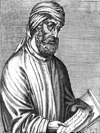
Theodosius the Great
Theodosius
I, Roman emperor from 379 to 395 AD,
was the last emperor to rule over both the eastern and western halves of
the Roman Empire. He is renowned for making Nicene
Christianity
the official state religion through the Edict of Thessalonica in 380
AD,
suppressing pagan practices, and enforcing religious orthodoxy.
Militarily, he defended the empire against Gothic, Hunnic, and other
barbarian invasions, notably securing victory at the Battle of the
Frigidus in 394 AD.
His reign stabilized the empire politically and administratively,
relying on federate barbarian troops while maintaining imperial
authority. Theodosius’ policies and religious reforms profoundly shaped
the future of the Roman Empire and the establishment of
Christianity
in Europe.

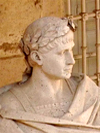
Theology
Term meaning “discourse on
God”. It derives from the Greek word Theologia (θεολογία), which itself
is a compound word of Theos (θεός) meaning “God” and logos (λόγος)
meaning “word”. In the pre-Christian Era, the Greek philosopher
Aristotle already used the term in reference to metaphysics, a branch of
philosophy that included discourses on Greek mythology and the nature of
the divine, i.e. analysis of the gods and of cosmology. Later early
Christian writers and apologists started to use the term for Biblical
and especially
Christian Theology, in order to define the study of God
and in a wider sense also the study of the religious faith in general.
Although technically, the term can also refer to religions other than
Christianity, it is however nowadays mostly used for
Christian and
Biblical Theology. This is in line with Christ as the Word (Logos) of
God (Theos), as is clearly described in John 1:1
“In the beginning the
Word already existed. The Word was with God, and the Word was God”.

Tiberius
Name of the second Roman
Emperor, who was born on 16 November 42 BC as Tiberius Claudius Nero. He
became Emperor of Rome in 14 AD, the death of Octavian Augustus. He was
the oldest son of Livia Drusilla, the wife of Augustus, and Tiberius
Claudius Nero, whom she had divorced, to remarry Augustus in 39 BC.
Augustus, who lacked a male heir, adopted Tiberius as his stepson, in 4
AD. He had first adopted his younger stepson Drusus, but he had died in
9 BC after falling from his horse. Tiberius would later marry a daughter
of Augustus from an earlier marriage, i.e. Julia the Elder. Being a Claudian (son of Tiberius Claudius Nero)
by birth and becoming a Julian (son of Octavian Augustus, also
known as Julius Caesar Octavianus) after his adoption, he was the first
emperor of both families, thus beginning a new dynasty that would be
known as the Julio-Claudian dynasty and would last for another forty
years. He was fully known as Tiberius Julius Caesar Augustus. Jesus of
Nazareth lived during Tiberius' reign and was executed under the
authority of Pontius Pilate, the Roman governor of Judea. Whether
Tiberius had heard of Jesus, or knew about His crucifixion is a matter
of speculation. Surely, word about Jesus and His miracles spread rapidly
throughout the Roman Empire, even to the Imperial Palace on Palatine
Hill, but in 26 AD Tiberius had retired to his palace on the Island of
Capri, leaving administration largely in the hands of some unscrupulous
prefects of the Praetorian Guards, which soon led to all sorts of
corruption in Rome. Meanwhile, there were many rumours about Tiberius
involving sexual perversity, cruelty and paranoia. He died on 16 March
37 AD, being very unpopular. In the Bible, Tiberius is mentioned by name only in Luke 3:1, where it is
recorded that John the Baptist started his public ministry in the 15th
year of his reign. But many other episodes also refer to Tiberius, e.g. the tribute money referred to in Matthew
22:19 and Mark 12:15 is generally thought to be a silver denarius of
Tiberius. Tiberias, the “city of Tiberius” situated on the western shore
of the Sea of Galilee, is
named after him.

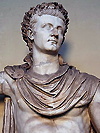
Tigris (תִּגְרִיס, Τίγρης)
Name of a river mentioned in the Hebrew Bible as
one of the four rivers flowing out of the Garden of
Eden
(Genesis 2:14). It is described as running east of Assyria,
distinguishing it from the
Pishon,
Gihon, and
Euphrates,
and has historically been identified with the modern Tigris River in
Mesopotamia, flowing through present-day Turkey and Iraq. In biblical
geography, the Tigris defines part of the fertile crescent region and
plays a role in the Eden narrative as a source of water nourishing the
primordial garden. Its inclusion in the Eden account highlights the
connection between the biblical conception of paradise and real-world
rivers of Mesopotamia, emphasizing abundance, life, and sustenance.
Later Jewish and
Christian traditions sometimes reference the Tigris
symbolically as part of God’s ordered creation and the ancient world of
early human civilization.

Torah (תּוֹרָה)
Hebrew. “Teaching” or
“instruction”. It is the first of three sections in the Tanakh and the
most sacred writing of the Jews. It is sometimes referred to as the
Law and also known as the Five Books of Moses, called Pentateuch,
from the Greek word Pentateuchos (Πεντάτευχος), meaning
“Five Books”.
These five books are the first five books of the Hebrew Scriptures and
the
Christian Old Testament, and are named after the first words of their texts, i.e.
Be-reshit (בְּרֵאשִׁית),
Shemot (שמות), Vayikra (ויקרא), Bamidbar (במדבר) and Devarim (דברים), in
Greek called Genesis (Γένεσις), Exodos (Έξοδος), Leviticon (Λευιτικόν),
Arithmoi (Αριθμοί) and Deuteronomion (Δευτερονόμιον), and in English
known as Genesis, Exodus, Leviticus, Numbers and Deuteronomy.


Tree of Knowledge
The Tree of Knowledge of Good and Evil, which was
placed the middle of the Garden of Eden and from which God directly
forbade to eat from its fruit. However, through the cunning temptation
of the serpent Adam and Eve violated the commandment of God and were
expelled from the garden of God. The fruit of the Tree of Knowledge is
in iconography often depicted as being an apple, though this is not specifically
mentioned in the Bible. The Vulgate, the Latin version of the Bible,
translated the Hebrew word for “fruit” by the Latin word pomum,
which in Latin also means “apple”, hence the confusion.

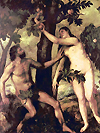
Triumphal Entry
The event in the
New Testament, described in
Matt. 21:1–11;
Mark 11:1–11;
Luke 19:28–44; and
John 12:12–19, when Jesus Christ
entered Jerusalem riding a donkey, an event commemorated on Palm Sunday.
According to the Gospels, crowds welcomed Him with palm branches and
cries of “Hosanna!”, recognizing Him as the Messiah and King. This event
fulfilled
Old Testament prophecy, notably
Zechariah 9:9, which foretells that the Messiah would come “riding on a
donkey”, symbolizing a kingship of peace rather than military conquest.
The Triumphal Entry marks the beginning of Holy Week, leading to Jesus’
Passion, crucifixion, and resurrection, and it occupies a central place
in Christian liturgy and artistic representation. The donkey itself, a
humble beast of burden, carries profound allegorical significance. Many
donkeys bear a distinctive cross-shaped marking on their back, formed by
the intersection of a dorsal stripe along the spine and a shoulder
stripe crossing the forelegs. As a lowly beast of burden, the donkey
reflects Jesus’ humility in taking upon Himself the sins of the world.
Just as the donkey bears its load meekly, Jesus humbles Himself to carry
His cross and the weight of humanity’s sins. For this reason, donkeys
with this cross-shaped marking are sometimes called Jerusalem donkeys,
underscoring their symbolic connection to Christ’s sacrificial entry
into the city.

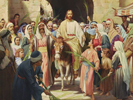
Tyndale
See
William Tyndale.
 |